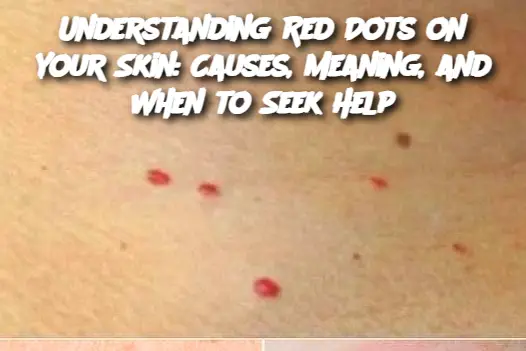Meningococcal infection: This serious bacterial infection can cause petechiae to develop quickly. It’s often accompanied by fever and a stiff neck and requires immediate medical attention.
Viral infections: Conditions like chickenpox, rubella, or the measles can cause red dots to appear along with other symptoms like fever, rash, and fatigue.
Vasculitis:
Vasculitis is inflammation of the blood vessels and can result in red dots on the skin, known as purpura. It can occur due to an autoimmune condition or an infection and may cause other symptoms like pain or swelling in the affected area.
Capillary Fragility:
In some cases, red dots can be due to fragile capillaries, often seen in the elderly or those with certain conditions like Cushing’s syndrome or chronic use of steroids. This can lead to the spontaneous appearance of red spots on the skin.
What Could Red Dots Mean for Your Health?
The presence of red dots may not always be a cause for concern, but the context and associated symptoms can provide important clues about your overall health:
Harmless Causes: Red dots that appear after minor trauma, such as a bump or pressure, usually resolve on their own and don’t require medical treatment.
Infections and Inflammation: If the red dots appear alongside other signs of illness (fever, fatigue, pain), this could indicate an infection or an inflammatory condition. In these cases, seeking medical advice is important to address the root cause.
Serious Conditions: Red dots that appear suddenly and are not associated with obvious trauma may indicate a more serious issue, such as a blood clotting disorder, an allergic reaction, or a viral infection like meningitis. If you experience red dots along with severe symptoms (difficulty breathing, dizziness, or prolonged fever), it’s important to seek medical attention immediately.
When to Seek Medical Help:
While most red dots on the skin are harmless and will resolve on their own, it’s important to seek medical attention if:
The red dots appear suddenly without any known cause.
You experience pain, fever, or other systemic symptoms.
The spots don’t fade when you press on them (this could indicate petechiae).
You have a history of bleeding or clotting disorders, or if you’re taking blood-thinning medications.
The red dots spread rapidly or appear in large clusters.
Tips for Managing Red Dots on Your Skin:
Avoid Scratching: If the red dots are accompanied by itching, avoid scratching to prevent further irritation or infection. Use gentle, soothing lotions like calamine to help calm the skin.
Monitor for Other Symptoms: Keep an eye on any changes in the appearance of the red dots. If they change color, grow in size, or develop into bruises, contact a healthcare provider.
Stay Hydrated: Proper hydration supports skin health and may help reduce some of the symptoms that could lead to the appearance of red dots, such as irritation or dryness.
Protect Your Skin: If you’re prone to bruising or petechiae, consider wearing protective clothing when engaging in activities that may cause injury or trauma to the skin.
Variants and Conditions That Could Cause Red Dots:
Heat Rash:
Heat rash, also known as prickly heat, occurs when sweat gets trapped in the sweat glands and causes red bumps or dots on the skin. This is common during hot weather or after exercise.
Hives:
Raised, itchy red welts that can form on the skin, often due to an allergic reaction. They are different from petechiae but can appear as red spots on the skin.
Shingles:
Shingles is a viral infection that causes painful, blister-like red spots on the skin. It’s usually accompanied by a burning or tingling sensation and should be treated with antiviral medication.
FAQ:
Can stress cause red dots on the skin?
Yes, stress can lead to conditions like hives or vasculitis, which may cause red spots or dots to appear on the skin.
Are red dots on the skin always serious?
Not necessarily. Many red dots are harmless and result from minor trauma or pressure. However, if they are sudden, persistent, or accompanied by other symptoms, it’s important to seek medical advice.
Can I treat red dots at home?
For minor cases like heat rash or post-injury spots, you can treat the area with cold compresses, aloe vera, or soothing lotions. However, if the spots don’t go away or if you suspect an underlying health issue, it’s best to consult a doctor.
Can diet affect the appearance of red dots on my skin?
Yes, poor nutrition, especially a deficiency in vitamins like vitamin C or K, can lead to easy bruising or the appearance of red spots. Ensuring a balanced diet with sufficient vitamins can help maintain skin health.
Conclusion:
Red dots on your skin can be caused by a wide range of factors, from harmless bruising to more serious conditions. Understanding the underlying cause and monitoring your symptoms is key to determining whether you need medical intervention. If you’re ever in doubt or notice other concerning signs, don’t hesitate to consult with a healthcare provider for a proper diagnosis and treatment.
ADVERTISEMENT

